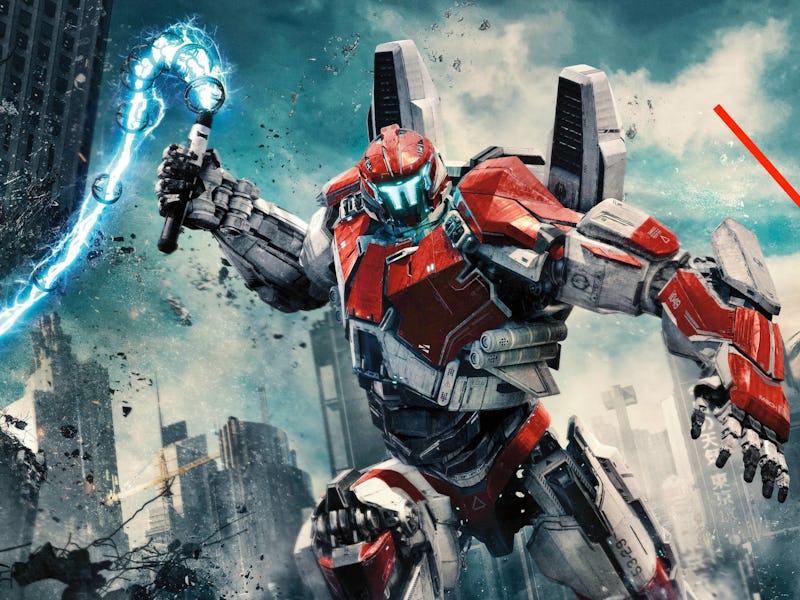'Pacific Rim Uprising': The Real-Life Science Behind "Rare-Earth Elements"

By the end of Pacific Rim Uprising, the film introduces yet another bit of fake science to explain the goal of the Kaiju and the Precursors controlling them, and it has everything to do with Mt. Fuji having a huge concentration of something Dr. Hermann Gottlieb calls “rare-earth elements.”
Spoilers follow about Pacific Rim Uprising and the real-life science that makes the whole finale seem a little bit ridiculous.
We learn part-way through Pacific Rim Uprising that Kaiju blood is highly reactive with rare-earth elements, which allows Dr. Gottlieb to make crazy rocket fuel that delivers enough propulsion to make a 7,000-ton Jaeger fly.
The grand plan of the Precursors is to throw a Kaiju into Mt. Fuji, which would cause a chain reaction between its blood and the rare-earth elements there. It would supposedly “activate” the Ring of Fire, the very real string of volcanoes and sites of seismic activity that encircles the Pacific Ocean.
Rare-earth elements are a real thing, but does the real-life science of this plan make any sense at all?
Uhhhh, not really.
Rare-earth elements make up 17 of the 118 elements on the periodic table. Calling them “rare” to begin with is something of a misnomer because these elements are actually quite common around the world; they’re just in the Earth’s crust and don’t cluster together in huge surface-level deposits like some other easier-to-obtain elements.
Positing that Mt. Fuji as the sole source — or even the best source — of these elements is factually incorrect.
Rare-earth deposits have been reported in Japan as well as in many other countries, including the United States, South Africa, Canada, Australia, Brazil, India, Russia, South Africa, Malaysia, and Malawi, according to Columbia University’s Earth Institute. However, the world leader in mining them is China, which has been the global leader in the mining of rare-earth elements since the Nineties, supplying 97 percent of the world’s demand and consuming most of what it mines to produce electronic devices.
The rare earth elements on the periodic table, divided into light and heavy.
The U.S. Department of Energy calls rare-earth elements the “technology metals” due to their unique magnetic, phosphorescent, and catalytic properties that allow for the development of various electronic technologies. They’re in everything from solar batteries to your iPhone screen. (All in all, the average iPhone uses eight rare-earth elements, which is part of the reason why the phones are all manufactured in China.)
They don’t really pose an explosion risk, though that doesn’t mean they’re not dangerous. Some researchers have suggested that we’re more at risk of toxicity from most rare-earth elements than we are of them blowing up the world through some crazy chain reaction. In Chinese villages where rare earth mining occurs, the tailings from refining the elements have created an environmental nightmare.
The Ring of Fire includes tons of sites that have more geological activity.
There is one Kaiju-sized nugget of truth to the Uprising theory: Active volcanoes are actually a decent place to find rare-earth elements. In 2013, for example, scientists discovered rare earths in the remains of the 2010 eruption of Merapi Volcano in Java, Indonesia. Extreme geothermic activity can create rare-earth elements through fission, and these in turn could rise up to the surface from the Earth’s crust during an eruption. Volcanoes do seem pretty exciting and rare on the surface of the planet, but they merely offer a small peek at what’s constantly going on deep inside the Earth.
If the Kaiju really wanted to hit a big enough deposit of rare-earth elements, it might have made more sense to bury right into underwater volcanos like Tamu Massif in the Pacific Ocean, rather than walking all the way to Mt. Fuji. Even Mauna Loa, the volcano that made the Hawaiian islands, is larger and seemingly more active than the legendary Japanese volcano.
Nevertheless, they seem pretty obsessed with the Pacific Ring of Fire for some reason, so perhaps they really need a way to cause a consistent chain reaction. And who knows what the world’s volcanic activity will look like in 2035, when Uprising is set.
We can’t possibly know what chemicals and elements are in the blood of Godzilla-sized monsters from a different dimension, so it remains entirely possible that it might react in explosive ways with the same metal used to make the battery in your cell phone.
Pacific Rim Uprising is out now in theaters.